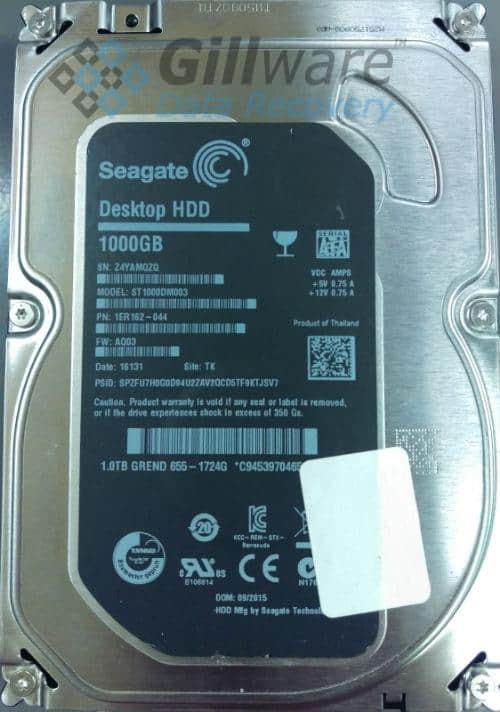Recovering Data from a Hard Drive After a Power Surge
Hard drives, like any electronic devices, need electricity to function. But they can also suffer a lot of damage if they’re exposed to too much electricity. For your phone, your TV, your computer, etc. an electrical surge is a bit like choking on a glass of water—or drowning. There’s a reason we invented surge protectors.
The job of a surge protector is to kick in when it detects a spike in voltage and (hopefully) prevent any serious damage to your electronics. Think of it as a sippy cup for your electronic devices. And surge protectors do a very good job most of the time—but sometimes, like all human inventions, their efforts fall a little short.
Has your hard drive failed due to a power surge?

How Does a Power Surge Damage a Hard Drive?
While your hard drive goes about its daily business, the printed control board on its bottom does a lot of work. It’s a one-way street for the electricity that powers the drive’s internal components, and a two-way street for your data. (Although, in the interest of accuracy, it’s more like a multi-lane freeway for your data.)
A power surge can’t do much to the mechanical components inside your hard drive. But the control board, with its circuitry, is vulnerable to voltage spikes. A hard drive power surge will often completely kill the drive’s control board. As a result, when you plug the hard drive back in, none of its components will receive any power. The spindle motor won’t spin. The platters won’t rotate. And the read/write heads won’t sweep into position. Your hard drive lies silent as a grave.
Data Recovery Software to recover
lost or deleted data on Windows
If you’ve lost or deleted any crucial files or folders from your PC, hard disk drive, or USB drive and need to recover it instantly, try our recommended data recovery tool.
Retrieve deleted or lost documents, videos, email files, photos, and more
Restore data from PCs, laptops, HDDs, SSDs, USB drives, etc.
Recover data lost due to deletion, formatting, or corruption

That’s a common story. But it’s not quite what happened to the client in this data recovery case study. The power surge that hit their unfortunate hard drive had left the control board clinging to life. Thus, the hard drive could receive enough power to turn on and read and write data—but only for a brief interval. This hard drive was only mostly dead.
Now, usually, “only mostly dead” is an improvement over “all dead” (just ask Miracle Max). But unfortunately, in the world of hard disk drives, the distinction between the two can be vanishingly small. A mostly dead hard drive is often just as much of a prison for everything you’ve stored on it as an all-the-way dead hard drive is.
Fortunately, though, Gillware’s data recovery services encompass “mostly dead” and “all dead” hard drives alike (as well as just about every other data loss situation under the sun).
Recovering from a Hard Drive Power Surge
To recover data after a hard drive power surge turned this client’s hard drive into a tomb for their photos, documents, and AutoCAD project files, our data recovery technicians had to replace the failing PCB. Since the PCB sits outside of the hard drive, these types of recoveries tend to be non-invasive. Or, at least, as long as PCB is the only damaged component, they tend to be non-invasive. It’s not unusual for failure of one component, such as the PCB, to precede (or succeed) the failure of another component, such as the read/write heads or motor.

Now, “non-invasive” makes the recovery process sound more easy than it is. Replacing a PCB takes a lot more work than simply swapping the boards from two identical models of hard drives. One of the chips on the PCB is a ROM chip, stuffed with drive-unique factory calibrations. Every hard drive’s calibrations are different—so if you give your hard drive calibration data meant for a different drive, it won’t work properly. As a result, hard drive PCB replacement also requires one of our electrical engineers to carefully transplant the ROM chips.
Data Recovery Case Study: Recovering from a Hard Drive Power Surge
Drive Model: Seagate ST1000DM003
Drive Capacity: 1 TB
Operating/File System: Windows (NTFS)
Data Loss Situation: Hard drive seemed to overhead and shorted out intermittently readable
Type of Data Recovered: Photos, documents, AutoCAD project files
Binary Read: 12.2%
Gillware Data Recovery Case Rating: 9
The client in this data recovery case study had a very terminally ill hard drive on their hands. Their hard drive wasn’t quite dead—at least not yet. But it was fading fast. When the user plugged it into their computer, the drive would only show up for a scant few seconds before vanishing. That certainly wasn’t large enough of a window of opportunity to pull any files off of the drive. The hard drive’s owner went to their local computer repair technician, who discovered that the drive felt unusually hot. After hypothesizing that a shorted-out circuit board, caused by a hard drive power surge, could be to blame, the repair technician got in touch with the hard drive data recovery professionals here at Gillware.
After pulling off the PCB transplant, our engineers successfully recovered 99.9% of our client’s important files, netting this data recovery case a 9 on our ten-point case rating scale.
Don’t let a power surge keep you from your data.

